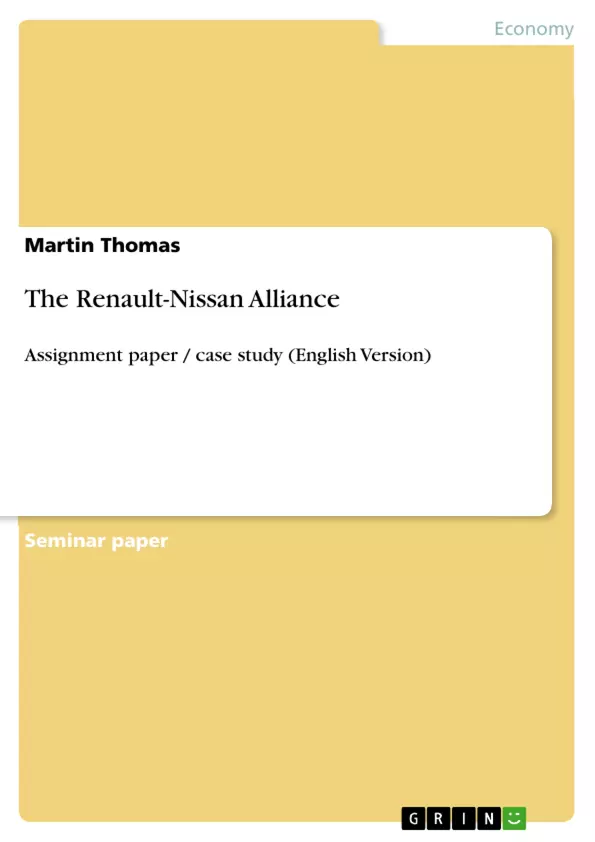This assignment paper analyzes the question, whether the alliance of two culturally different automobile giants was a success or not. Was Nissan be abled to use synergy effects of Renault and was Renault be abled to use Nissans benefits? In the analysis of the given case, the most common marketing strategies will be dopted: Michael Porter's Diamond / Five Forces, the cultural web, Hofstede's cultural dimensions, Porter's generic strategies, SWOT, PESTLE and Resource based view and Market based view.
Inhaltsverzeichnis (Table of Contents)
- 1 Introduction
- 1.1 Executive Summary
- 1.2 Introduction into the case study
- 2 Basic facts: Resources and capabilities
- 2.1 The cultural web
- 2.2 Globalization drivers
- 2.3 Cultural differences
- 3 Critical analysis
- 3.1 Factor conditions
- 3.2 Firm strategy and structure
- 3.3 Related and supporting industries
- 3.4 Demand conditions
- 4 Results
- 5 Conclusion
Zielsetzung und Themenschwerpunkte (Objectives and Key Themes)
This case study analyzes the Renault-Nissan Alliance, examining its formation and performance within the global automotive industry. The study aims to understand the factors contributing to the alliance's success and challenges, considering cultural differences and market dynamics.
- Globalization and its impact on the automotive industry
- Cultural differences and their influence on strategic alliances
- Competitive dynamics and strategic responses in the automotive sector
- The role of mergers and acquisitions in shaping the industry landscape
- Analysis of resource capabilities and their contribution to success.
Zusammenfassung der Kapitel (Chapter Summaries)
1 Introduction: This introductory chapter provides a historical overview of the automotive industry, highlighting its growth and the increasing importance of globalization. It sets the context for the case study by discussing the rise of Japanese car manufacturers, the subsequent reactions of American and European companies, and the trend of mergers and acquisitions within the industry, which eventually led to a smaller number of major players controlling a significant portion of the global market. The chapter establishes the importance of understanding the competitive dynamics and challenges involved in the industry.
2 Basic facts: Resources and capabilities: This chapter delves into the foundational elements of the Renault-Nissan Alliance, focusing on its resources and capabilities. It likely explores the cultural web of both companies, the drivers of globalization that influenced their alliance, and the cultural differences between them, paving the way for a detailed analysis of the complexities in integrating two distinct corporate cultures.
3 Critical analysis: This section offers a detailed analysis of the Renault-Nissan Alliance through the lens of Porter's Five Forces, examining the factor conditions, firm strategy, related and supporting industries, and demand conditions. It probably explores how these factors affected the alliance's competitive positioning and overall success.
4 Results: This chapter will likely present the findings of the case study analysis. It would summarize the key successes and failures of the Renault-Nissan alliance, likely using data and evidence from the previous chapters.
Schlüsselwörter (Keywords)
Renault-Nissan Alliance, automotive industry, globalization, cultural differences, strategic alliances, mergers and acquisitions, competitive advantage, resource capabilities, market dynamics.
Renault-Nissan Alliance Case Study: Frequently Asked Questions
What is the purpose of this case study?
This case study analyzes the Renault-Nissan Alliance, examining its formation and performance within the global automotive industry. It aims to understand the factors contributing to the alliance's success and challenges, considering cultural differences and market dynamics.
What are the key themes explored in the case study?
Key themes include globalization's impact on the automotive industry, the influence of cultural differences on strategic alliances, competitive dynamics and strategic responses in the automotive sector, the role of mergers and acquisitions, and the analysis of resource capabilities contributing to success.
What topics are covered in each chapter?
Chapter 1 (Introduction): Provides a historical overview of the automotive industry, highlighting globalization's increasing importance and the rise of mergers and acquisitions. It sets the context for the Renault-Nissan case study.
Chapter 2 (Basic facts: Resources and capabilities): Explores the foundational elements of the Renault-Nissan Alliance, focusing on its resources and capabilities. This includes examining the cultural web of both companies, globalization drivers influencing their alliance, and the cultural differences between them.
Chapter 3 (Critical analysis): Analyzes the Renault-Nissan Alliance using Porter's Five Forces, examining factor conditions, firm strategy, related and supporting industries, and demand conditions. It assesses how these factors impacted the alliance's competitive positioning and success.
Chapter 4 (Results): Summarizes the key successes and failures of the Renault-Nissan alliance, using data and evidence from previous chapters.
Chapter 5 (Conclusion): [Content not explicitly detailed in the provided preview.]
What is included in the language preview?
The preview offers a comprehensive overview including the title, table of contents, objectives and key themes, chapter summaries, and keywords.
What are the key words associated with this case study?
Keywords include Renault-Nissan Alliance, automotive industry, globalization, cultural differences, strategic alliances, mergers and acquisitions, competitive advantage, resource capabilities, and market dynamics.
What is the Table of Contents?
The Table of Contents includes: 1. Introduction (1.1 Executive Summary, 1.2 Introduction into the case study); 2. Basic facts: Resources and capabilities (2.1 The cultural web, 2.2 Globalization drivers, 2.3 Cultural differences); 3. Critical analysis (3.1 Factor conditions, 3.2 Firm strategy and structure, 3.3 Related and supporting industries, 3.4 Demand conditions); 4. Results; 5. Conclusion.
- Citar trabajo
- Martin Thomas (Autor), 2012, The Renault-Nissan Alliance, Múnich, GRIN Verlag, https://www.grin.com/document/208787



